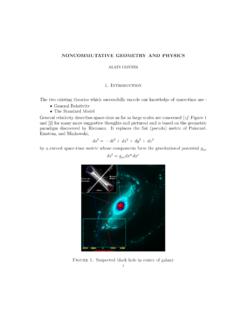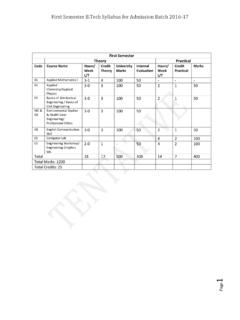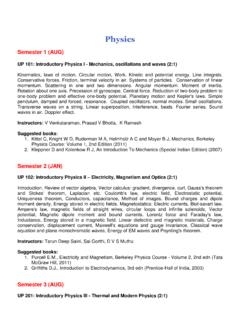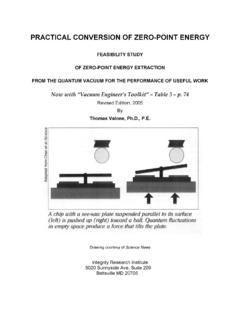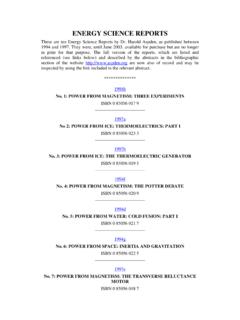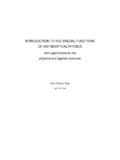Transcription of An Outline of General System Theory (1950)
1 An Outline of General System Theory (1950) ludwig von bertalanffy 1 Parallel Evolution in Science As we survey the evolution of modern science, we find the remarkable phenomenon that similar General conceptions and viewpoints have evolved independently in the various branches of science, and to begin with these may be indicated as follows: in the past centuries, science tried to explain phenomena by reducing them to an interplay of elementary units which could be investigated independently of each other. In contemporary modern science, we find in all fields conceptions of what is rather vaguely termed wholeness. It was the aim of classical physics eventually to resolve all natural phenomena into a play of elementary units, the characteristics of which remain unaltered whether they are investigated in isolation or in a complex. The expression of this conception is the ideal of the Laplacean spirit, which resolves the world into an aimless play of atoms, governed by the laws of nature.
2 This conception was not changed but rather strengthened when deterministic laws were replaced by statistical laws in Boltzmann s derivation of the second principle of thermodynamics. Physical laws appeared to be essentially laws of disorder, a statistical result of unordered and fortuitous events. In contrast, the basic problems in modern physics are problems of organisation. Problems of this kind present themselves in atomic physics, in structural chemistry, in crystallography, and so forth. In microphysics, it becomes impossible to resolve phenomena into local events, as is shown by the Heisenberg relation and in quantum mechanics. Corresponding to the procedure in physics, the attempt has been made in biology to resolve the phenomena of life into parts and processes which could be investigated in isolation. This procedure is essentially the same in the various branches of biology. The organism is considered to be an aggregate of cells as elementary life-units, its activities are resolved into functions of isolated organs and finally physico-chemical processes, its behaviour into reflexes, the material substratum of heredity into genes, acting independently of each other, phylogenetic evolution into single fortuitous mutations, and so on.
3 As opposed to the analytical, summative and machine [135]theoretical viewpoints, organismic conceptions1 have evolved in all branches of modern biology which assert the necessity of investigating not only parts but also relations of organisation resulting from a dynamic interaction and manifesting themselves by the difference in behaviour of parts in isolation and in the whole organism. The development in medicine follows a similar Virchow s programme of cellular pathology, claiming to resolve disease into functional disturbances of cells, is to be supplemented by the consideration of the organism-as-a-whole, as it appears clearly in such fields as Theory of human constitutions, endocrinology, physical medicine and psychotherapy. Again we find the same trend in psychology. Classical association psychology tried to resolve mental phenomena into elementary units, sensations and the like, psychological atoms, as it were. Gestalt psychology has demonstrated the existence and primacy of psychological entities, which are not a simple summation of elementary units, and are governed by dynamical laws.
4 1 L. von bertalanffy , Das biologische Weltbild, Band I. Die Stellung des Lebens in Natur und Wissenschaft, Bern, 1949 2 L. von bertalanffy , Biologie und Medizin, Wien, 1946 Corresponding developments are found in the social sciences. In classical economic doctrine, society was considered as a sum of human individuals as social atoms. At present there is a tendency to consider a society, an economy, or a nation, as a whole which is superordinated to its parts. This conception is at the basis of all the various forms of collectivism, the consequences of which are often disastrous for the individual and, in the history of our times, profoundly influence our Civilisations appear, if not as superorganisms, as was maintained by Spengler, at least as superindividual units or systems, as expressed in Toynbee s conception of history. In philosophy, the same General trend is manifest in systems so radically different as Nicolai Hartmann s Theory of categories, the doctrine of emergent evolution, Whitehead s organic mechanism, and dialectic materialism; all these are systems which are diametrically opposed in their scientific, metaphysical and social backgrounds, but agree in maintaining that principles of dynamic wholeness are basic in the modern conception of the world.
5 Thus, similar fundamental conceptions appear in all branches of science, irrespective of whether inanimate things, living organisms, [136]or social phenomena are the objects of study. This correspondence is the more striking because these developments are mutually independent, largely unaware of each other, and based upon totally different facts and contradicting philosophies. They open new perspectives in science and life, but also involve serious danger. Thus it appears that there is a General change in the scientific attitude and conceptions, and the question arises: what is the origin of these correspondences? 2 Isomorphic Laws in Science Not only are General aspects and viewpoints alike in different fields of science; we find also formally identical or isomorphic laws in completely different fields. This is a well-known fact in physics where the same differential equations apply, for example, to the flow of liquids, of heat, and of electric currents in a wire.
6 But it appears that the significance of this fact, and the possibilities it opens in fields outside physics, have hardly been considered. For example, the exponential law or law of compound interest applies, with a negative exponent, to the decay of radium, the mono-molecular reaction, the killing of bacteria by light or disinfectants, the loss of body substance in a starving animal, and to the decrease of a population where the death rate is higher than the birth rate. Similarly, with a positive exponent, this law applies to the individual growth of certain micro-organisms, the unlimited Malthusian growth of bacterial, animal, or human populations, the growth curve of human knowledge (as measured by the number of pages devoted to scientific discoveries in a textbook on the history of science), and the number of publications on The entities concerned atoms, molecules, bacteria, animals, human beings, or books are widely different, and so are the causal mechanisms involved.
7 Nevertheless, the mathematical law is the same. Another equation, the logistic law of Verhulst, is, in physical chemistry, the equation of autocatalytic reaction, and in biology, it describes certain cases of organic growth. It was first stated in demography to describe the growth of human populations in a limited space of living. It governs also the advancement of technical inventions, such as the growth of the railway System in the United States during the last century, or of the number of wireless sets in [137]operation. What 3 F. A. Hayek, The Road to Serfdom, Chicago, 1944 4 A. H. Hersh, Drosophila and the Course of Research, Ohio J. of Science, 1942, 42, 198-200 is known in national economy as Pareto s law1 5of the distribution of income within a nation, represents, in biology, the law of allometric growth, describing the relative increase of organs, chemical compounds, or physiological activities with respect to body size.
8 Volterra6 has developed a population dynamics, comparable to mechanical dynamics, working with homologous concepts such as demographic energy and potential, life action, etc., and leading to a principle of minimum vital action, corresponding to the principle of minimum action in mechanics. Actually, principles of minimum action appear in widely different fields besides mechanics, for example, in physical chemistry as the principle of Le Chatelier and in electrodynamics as Lenz rule. Again, the principle of relaxation oscillations governs the neon lamp, but also important phenomena in nerve physiology and certain phenomena of biocoenoses or organic communities. The same is true for phenomena where the General principles can be described in ordinary language though they cannot be formulated in mathematical terms. For instance, there are hardly processes more unlike phenomenologically and in their intrinsic mechanisms, than the formation of a whole animal out of a divided sea-urchin or newt germ, the re-establishment of normal function in the central nervous System after removal or injury to some of its parts, and gestalt perception in psychology.
9 Nevertheless, the principles governing these different phenomena show striking similarities. Again we ask: what is the origin of these isomorphisms? There are three obvious reasons. The first is in the trivial fact that while it is easy to write down any complicated differential equation yet even innocent-looking expressions may be hard to solve, or give, at least, cumbersome solutions. The number of simple differential equations which are available and which will be preferably applied to describe natural phenomena is limited. So it is no wonder that laws identical in structure will appear in intrinsically different fields. A similar consideration holds for statements formulated not in mathematical but in ordinary language: the number of intellectual schemes available is rather restricted, and they will be applied in quite different realms. However, these laws and schemes would be of little help if the world ( the totality of observable events) was not such that they [138]could be applied to it.
10 We can imagine a chaotic world or a world which is too complicated to allow the application of the relatively simple schemes which we are able to construct with our limited intellect. Fortunately, the actual world is not of this sort, and does allow the application of our intellectual constructions. But there is yet a third reason for the isomorphism of natural laws and this is most important for our present purpose. Laws of the kind considered are characterised by the fact that they hold generally for certain classes of complexes or systems, irrespective of the special kind of entities involved. For instance, the exponential law states that, given a complex of a number of entities, a constant percentage of these elements decay or multiply per unit time. Therefore this law will apply to the pounds in a banking account as well as to radium atoms, molecules, bacteria, or individuals in a population. The logistic law says that the increase, originally exponential, is limited by some restricting conditions.
